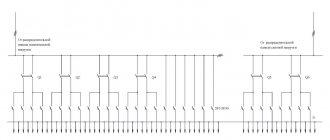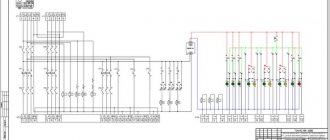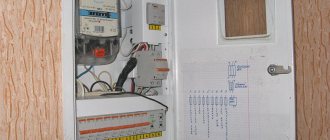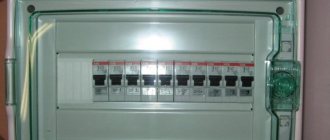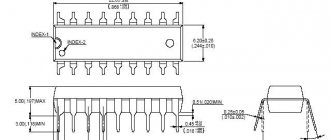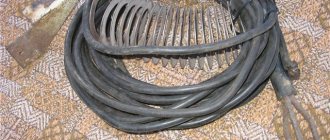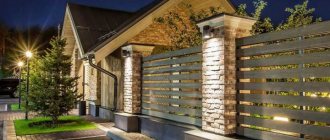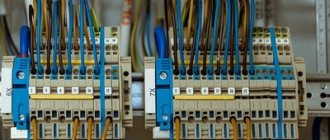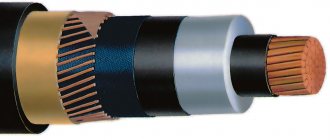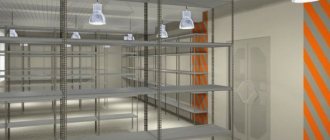Electrician in the house
Encyclopedia about electricity from A to Z
Masters catalog
Find the best master or company in your city
Selecting and installing a lighting panel
Lighting panels are one of the most critical elements of the electrical network of an apartment or house. That is why you should approach their installation as carefully as possible and avoid mistakes.
After all, the performance of the entire electrical network directly depends on this node, and its damage will lead to a long-term blackout of all consumers powered by it.
- Location and dimensions of the distribution board Location of the lighting board
- Distribution board dimensions
- Single-phase distribution boards
Street lighting functions
Regardless of the scale of the object - be it a local area or a highway - it needs to be illuminated at night.
Light is needed for the safe movement of residents of the house, ensuring the movement of vehicles, decorative lighting of buildings or their individual elements, illumination of advertising on billboards, etc. As for private housing, in addition to illuminating the entrance to the house, lighting performs the following functions:
general lighting of the area (important from a safety point of view); lighting of steps into the house; lighting of pedestrian paths; lighting of local areas (for example, near the gazebo); decorative lighting of architectural and landscape features of the site.
What does the system include?
Automatic lighting control includes a complex of high-tech devices that are capable of operating in an automated and automatic mode, that is, without human intervention. The system design consists not only of lighting fixtures, but also of sensors and auxiliary devices. You can connect new external devices at any time, because the system is scalable. Equipment list:
- Smart switches that can be turned on and off both in normal manual mode and after appropriate commands from the control panel. There are mechanical and touch switches.
- Smart dimmers are devices designed to smoothly change the power of lighting fixtures. In other words, they are used for automated editing of lighting brightness.
- Smart lamps - have the ability to turn on and off automatically, as well as smoothly change the brightness of their glow. Some models can change color and temperature.
- LED strips have the same capabilities as smart lamps. At the same time, they are characterized by lower energy consumption, increased safety of use, and a long service life.
An equally important role in lighting system automation is played by sensors that monitor changes in the environment. In the schemes under consideration, the greatest demand is for sensors that respond to movement, presence, opening and closing doors and windows, and changes in lighting levels. Automation can also successfully interact with other building systems, including fire alarms or HVAC.
What applies to the self-needs shield?
Personal needs include the following things: heating and cooling systems, power supply devices and on-load tap-changers in power transformers, control circuits for devices, lighting, heating of buildings, etc.
A direct current control panel is a unit used at stations in certain electrical installations, substations and various production facilities where it is necessary to distribute direct current through circuits. There are special rechargeable batteries and chargers that provide constant current.
Electrical distribution boards with a mounting panel are of the ShchMP-01 type. This unit is small in size, which makes it possible to install it on the floor, in an apartment or in a specific house. Such electrical distribution boards cling to the wall and have great protection from negative environmental influences. The design of the mechanism also includes a zip lock that protects the device from illegal entry.
Electrical distribution boards have an analogue of ShchRNM-2, which is a hinged ShchR switchboard hanging on the street, having a mounting panel to install other automation. The highest level of protection IP-54 makes it possible to install these devices on the walls of buildings. The doors have a protective feature in the form of a lock.
If you need to install a distribution board shchr in order to install elements for a “multiple house,” then you need to use a low-flow panel of the Volta type. This device is designed for seventeen modules and has a built-in four-row panel equipped with switches for regulating the “smart house” system.
Electrical distribution boards of the ShchRN-12 model are an internal type model, which is equipped with 12 modules. It is possible to buy models that have nine modules included. Electrical distribution boards can ideally protect a garage or cottage from power surges. They are three-phase, where the standard characteristics of voltage and current frequency are 380/70.
Manual control
The transition to manual lighting control is carried out in the following cases:
- For network repairs during the daytime.
- To activate lighting when the control relay is faulty.
- Turning on the lighting in situations where the control relay does not operate under specified conditions.
Switches are located on the door or side surface of the lighting panel, thanks to which the transition to manual control is carried out. You can perform manual activation in several ways:
- Switch for indoor or outdoor installation.
- By moving the manual control key to one of the positions.
- Push-button control station - industrial version.
The operation of the control relay depends on sensors located in the most convenient places. Often, photo relays are placed under shields and lighting supports. Sensors are connected to the circuit with cables using terminal blocks mounted on a DIN rail.
If the load connected to the external lighting panel exceeds the maximum permissible, then it is connected through the starter. In this case, the relay is responsible for turning on the starter, which, in turn, turns on the lamps.
How to connect
In order to connect lighting to the panel, you need an appropriate circuit. This diagram must contain clear markings so that the lighting connection is carried out correctly. It is best if the diagram is always in front of your eyes during the connection process.
Panel connection diagram
Switchboards for distributing electrical currents are installed separately and then connected using input devices to the general electrical network. Here you need the connection diagram given above. After connecting the shield, the electric current will be distributed to the final carriers. The entire process of electricity transmission is controlled by special devices. If connected correctly, the shield will fully perform its job, and the risk of malfunctions will be minimized.
Installation of lighting board
When the preparatory work is completely completed, you can proceed directly to the installation. The installation process will depend on the number of phases.
Single-phase lighting boards
Today, lighting panels with single-phase consumers are the most popular.
Connecting a single-phase lighting panel
The installation process for such shields is as follows:
- Before starting installation, you need to study and prepare a single-line diagram. Some attach the circuit later on the electrical panel door.
- The installation process begins with attaching DIN rails. You can attach all modern switching devices to them. Some designs already have din rails, but in most cases they will need to be redone.
- It is advisable to immediately install tires for fastening the wires. These tires can later be attached to slats or to a box. It all depends on their design.
- Now you can begin installing the equipment on the slats. Fastening is carried out using a spring mechanism.
- According to PUE standards, food will always be on the left. Therefore, if you open the electrical panel for the first time, you can be sure that the input machine is located in the upper left corner. If there is a backup power supply, it is usually located on the right.
- If the design has an input circuit breaker, then the phase wire is installed immediately below it. Terminal blocks for neutral wires may be located slightly lower. In some cases, they are also placed on the side walls of the cabinet.
- Subsequently, group circuit breakers are powered from the phase terminal block. Therefore they are located below the tires.
The photo shows a three-line diagram of the distribution panel
- If you decide to install RCDs, then they need to be placed below the group machines. You can also place additional equipment in this row.
- Once the power equipment is installed, you can begin connecting it. To do this, you will need a schematic diagram of the lighting board. It allows you to trace every wire.
- When the distribution panel is opened inside, it can be mounted at a permanent installation site.
Three-phase SCHO
Installation, as well as manufacturing, which is carried out in a three-phase version, is practically the same, but there are certain nuances.
The photo shows a three-phase wiring diagram for the lighting panel
Now let's look at the nuances that you may encounter during installation:
- The main difference is the ability to connect three-phase and single-phase loads. Depending on the load types, there is also the option for a single-phase load to be powered by 2 or 3 different phases.
- The first possible option is power supply from an input circuit breaker for three-phase and single-phase loads. In this case, below the input machine, you will need to place three busbars of phase wires. Single-phase and three-phase loads can be powered from them. In another, the principle of constructing such a shield will be similar to a single-phase one.
- If only single-phase loads will be supplied from a three-phase input circuit breaker, then in this case, three busbars for phase conductors must be installed below the input circuit breaker at the same level. Separate groups can be powered from each of these buses.
Ready-to-install lighting panels
Nowadays, ready-to-install lighting distribution boards are also available on the market. Their design already contains all the necessary equipment, which is quite simple to connect. There are many types of such shields, so there is no point in considering each one.
- The designation of the configuration and type of device will be placed at the top. The first character indicates the presence of an introductory machine. If the number is “1”, then this means that there is a switch without built-in protection. The symbol “1A” indicates that there is a switch with built-in protection. The symbol “1D” indicates that the design has a circuit breaker with built-in residual current protection. Accordingly, the number “0” means that the device does not have an input machine.
- The following numbers indicate the rated current for which the lighting board is designed.
- The number of circuit breakers and RCDs is indicated through the fraction.
In addition, in the designation you can find the following letters:
- “U” - indicates the need to build the shield into a niche;
- “Sch” – the presence of a meter in the design of the meter panel;
- “F” – the presence of additional control devices, as well as alarms.
Shields for portable lighting
Box with a step-down transformer YTP
According to PUE 7 (latest edition), for portable lamps used in high-risk premises, it is allowed to use a supply voltage of no more than 50 Volts. To obtain it, potential-reducing transformers are used that convert the 220 Volt network into 12, 24, 36 or 48 Volts.
To service portable illuminators, prefabricated shields of a special design are produced, which include the following components:
- voltage transformer;
- machine used for entry protection;
- automatic machines protecting lines going to consumers;
- socket for connecting portable lamps.
In some cabinet models, cable lines are routed from the secondary winding of the transformer through an automatic machine to stationary lamps that are constantly located in one place.
According to the PUE, hazardous conditions in which the use of portable lamps is mandatory include work performed in confined spaces:
- in trenches (when laying cable lines, for example);
- in inspection pits and basements;
- inside tanks and bulk tanks;
- when the worker is in an awkward position;
- if there is a possibility of contact with elements of grounding devices.
In all of the above situations, the permissible voltage should not exceed 12 Volts.
The step-down transformer can be installed in the distribution panel itself, for which it is provided with a special box from the YaTP series.
Manual control
The transition to manual lighting control is carried out in the following cases:
- For network repairs during the daytime.
- To activate lighting when the control relay is faulty.
- Turning on the lighting in situations where the control relay does not operate under specified conditions.
Switches are located on the door or side surface of the lighting panel, thanks to which the transition to manual control is carried out. You can perform manual activation in several ways:
- Switch for indoor or outdoor installation.
- By moving the manual control key to one of the positions.
- Push-button control station - industrial version.
The operation of the control relay depends on sensors located in the most convenient places. Often, photo relays are placed under shields and lighting supports. Sensors are connected to the circuit with cables using terminal blocks mounted on a DIN rail.
If the load connected to the external lighting panel exceeds the maximum permissible, then it is connected through the starter. In this case, the relay is responsible for turning on the starter, which, in turn, turns on the lamps.
Tools
Devices that will be needed to install the switchboard into the wall:
- ⚡
bubble or laser level - ⚡
pencil, marker - ⚡
hammer drill with a set of drills for concrete 6-10mm or grinder with a disc for concrete - ⚡
chisel (spade or blade) for a hammer drill (to knock out a niche) - ⚡
spatula for cement mortar - ⚡
knife for removing plugs in the cable entry panel
Installation (installation) of lighting panels
In our company, you can purchase an OSCH panel for street (external) or internal lighting in a suitable configuration, possibly in an open design, completely corresponding to your design. If you purchase an external version of ShchO, then its design involves the use of moisture-proof gaskets and a frost-resistant housing. Installation of the product is carried out in a special niche or involves mounting it to the wall. Our specialists will professionally carry out installation, connect and check, and also instruct employees who have access to it. The price of the product is determined by the configuration, and the cost of work is determined by the complexity and number of installed devices.
Preparing to install the distribution board
Before starting assembly, you need to do the following:
- select a ShchR shield that will match the type of wiring;
- calculate the entire volume of power load for absolutely each grouping;
- calculate the load on all power groups of all devices;
- determine the places where RCD operation is necessary.
A good option would be if the mounting panel provides backup locations for auxiliary RCDs. This may be useful for a private home. When purchasing a ShchR shield housing, you need to take into account the presence of additional two or three platforms.
OSCH classification
Metal lighting panel
Modern electrical lighting panels are classified according to a number of characteristics, the main ones being the housing material and installation method. All OShch models are divided into products made from the following materials:
- metal;
- non-flammable plastic.
Metal cases are used in panel structures that are intended to be used outdoors. Therefore, they are reliably protected from external influences and bad weather and have a high IP rating.
To extend their service life, standard street panels are additionally treated with special impregnations and coatings. A high degree of security allows them to be installed at sites with increased operational hazard. Their non-flammable plastic counterparts have an attractive appearance and are suitable for indoor placement.
A distinctive feature of this type of shields is their fire safety, since the plastic used in their manufacture does not burn.
Depending on the installation method, the lighting control panel may have the following designs:
- in the form of a suspended structure;
- product built into the wall.
Built-in switchboards installed in corridors and staircases must be equipped with locks, the keys of which are kept by the electrician on duty
Most of them have an attractive design and are installed in places where aesthetics are of particular concern. If the general atmosphere is disrupted, it is recommended to install them in niches available in most service rooms
Emergency transfer of reserve (ATS)
The AVR panel is equipped with special automation. The automatic transfer switch switches power from the main source to an additional one (generator) in the event of a failure of the main electricity supplier. After eliminating the accident, the ATS will transfer from the generator to the main line and after a few minutes the generator will be stopped. Used in industrial, commercial, communal buildings, as well as in cottages.
Emergency transfer of reserve (ATS)
External lighting panel
External lighting panel
Special control panels for outdoor lighting differ from conventional products in the organization of network activation, which can be done manually or automatically. The following electronic components are used for automatic load switching:
- motion sensors that record movement in the illuminated space;
- photo relay that responds to the level of illumination in the controlled area;
- sound sensors;
- time relays that turn on the load at the right moment.
Manual activation
Location of switches on the panel body
This lighting control mode is used in the following cases:
- during routine maintenance or emergency repairs;
- when automation systems fail;
- if necessary, setting up and testing new equipment.
To switch the system to manual mode, use special switches installed on the panel door or on its side panel. You can perform this switching in one of the following ways:
- moving the manual control key to the desired position;
- through a special switch installed on the outside or inside the cabinet;
- using a push-button station (this option is most often used in factory settings).
To switch the panel to group lighting control in automatic mode, you will need to switch back.
Checking the operation of the control panel
The price for installing a distribution cabinet includes checking the functionality of the electrical installation. It is done by massively (sequentially) turning on all possible consumers, after which it is necessary to walk around the entire facility, checking each outlet using some known working portable electrical appliance. If the automation does not turn off the power to the line at any stage, it means that the installation was carried out correctly.
Then you need to observe the control panel in full load mode for some time. If there is sparking, smoke, a crackling sound is heard, or a burning smell is felt, this indicates unreliable contact in one of the connections, causing overheating, or a malfunction of the automation device that needs to be replaced.
In the absence of the above phenomena, it is recommended to check the functionality of the main components that ensure the safe operation of the internal electrical system - the RCD. For this, a special tester is used that creates leaks of a standardized value (10, 30, 300 mA). The price of this device is quite affordable even for a private master. Some models are equipped with their own control button, which, when pressed, should instantly turn off the device.
What criteria are used to choose outdoor lighting?
The responsibility of choosing lighting for urban areas should not be discussed. Everything must be thought out and executed with maximum precision. Each lamp or lantern must comply with the list of standards:
- Each lantern must provide good illumination of the surrounding areas, regardless of its placement. The lamp must comply with all standards and requirements.
- Each lighting device must provide additional safety on the road and in the pedestrian area. It has long been proven that due to poor lighting, accidents occur several times more often.
- All lanterns and lamps should look aesthetically pleasing and not “cut” the eyes of passers-by. They must perform architectural and design functions.
- Each lantern should have a long service life so that they do not have to be replaced every year. Durability is a very important criterion, because all lighting fixtures work for hours and are constantly subjected to incredible voltage and load. Therefore, the body of such flashlights must have maximum strength, reliability and resistance to damage. Lampshades usually have impact-resistant glass.
- Saving is probably the most important factor, especially in the CIS countries. The modern world has catastrophic energy problems, so you need to save on this parameter. A small city consumes an incredible amount of energy per day, so it is necessary to replace outdated streetlights with more economical options. The best option is LED lighting, which also has a long service life and reliability.
ShchO working conditions
| Height above sea level | up to 2000 m |
| Temperature range (standard) | from -5°С to +40°С |
| Relative humidity (at 25°C) | up to 85% |
| Type of external environment | non-explosive, the content of corrosive agents corresponds to atmosphere type II or III according to GOST 15150 |
Safety and reliability | |
| Degree of protection of the cabinet outer shell (standard versions) | IP31, IP41, IP43, IP54 |
| Resistance to mechanical factors | M4 |
| Standard climate versions | UHL3 or T3 |
| Seismic resistance | up to 6 points (with installation height up to 20m.) |
| NKU service life | 30 years |
Where are lighting control systems used?
As mentioned above, lighting control systems either significantly save energy or are used for comfort in smart homes. To significantly save energy, professional lighting control systems are used at a variety of facilities:
- warehouses;
- office and administrative buildings;
- hotels;
- parking and protected areas;
- multi-apartment residential buildings;
- industrial enterprises;
- shopping complexes;
- educational institutions;
It is very important to correctly design a lighting control system at the building planning stage, but it can also be used in an existing building. Use suitable and reliable equipment in the project, think through the management of lighting groups, plan the system operation algorithm, all this is necessary for stable operation of the system
Naturally, for each type of object the control system will be individual, but standard solutions for premises are also available.
Placing shields
The following requirements apply to the location and installation of lighting panels:
- The panels are installed at a distance of one meter from sewer lines, gas pipelines and water pipes. In this case, the room in which the switchboard is located should not be subject to flooding. If the operation of the lighting board and power cabinets will be carried out in a room that may be flooded, then they are installed above the possible flood limit.
- Much depends on the correct choice of distribution board. When selecting, take into account the installation method of the lighting board - built-in or mounted. The built-in method is considered the most convenient, since a structure installed in this way takes up a minimum of free space and is additionally protected from temperature and mechanical influences.
- When installing a switchboard yourself, you must take into account the material from which it is made. Its choice is made based on the location of the panel room: if it is made of combustible materials, then the panel itself must be made of steel. If the shield is installed on a base made of non-flammable materials, then it can be made of low-flammable materials.
- External lighting panels are installed at a height of 20 centimeters from the ground or concrete base. If there is a high probability of snow drifts, then the shields are installed on a special foundation.
- Equipped with pulse relays, counters and measuring devices, external panels must be equipped with heating. The exception is switchboards with devices that retain functionality at temperatures below 5 degrees.
Location and dimensions
Before you begin installing the lighting panel, you need to perform a number of preparatory work. You also need to choose the right sizes.
ShchO location
One of the main rules is location. It must comply with a number of rules, which we will familiarize ourselves with in detail. Clause 7.1.28 of the PUE states that the location should be convenient for maintenance. In addition, installation cannot be carried out in rooms located under showers, bathtubs or bathhouses.
Niche in the wall for installing a shield
Here are additional rules to follow:
- The distance from communication pipes should be 1 meter. In this case, it is necessary to completely exclude the option of flooding. The level of the shield from the floor should be higher than the possible flood level.
- Experts consider design selection to the next stage. Here you will need to decide on the installation location of the structure. The installation option can be built-in or wall-mounted. The first option is more suitable since it does not take up much space.
- If you decide to do the installation yourself, then you need to pay attention to the material. In this matter, the location of the shield installation will be of fundamental importance.
- For installation in the house, it is better to choose plastic lighting panels. For the street, you can choose a metal structure. The second option also requires a ground connection.
- The structure should be installed at a height of 20 cm from the floor. On the street, it is better to install the structure at a height of 1 meter.
- If measuring instruments will be installed in the street lighting panel, then it is necessary to organize its heating.
Dimensions
Now it's time to decide on the size of the distribution board. This factor in most cases depends on the amount of equipment you decide to connect. Therefore, before purchasing, you first need to decide what will be installed here.
SCHO dimensions
To choose the optimal size, pay attention to:
- Decide on the introductory machine. If they are already present on the floor board, then installation will be impractical.
- Experts recommend installing a separate input circuit breaker only if the electrical switchboard receives power from a distribution panel with circuit breakers that have a higher rated current.
- If you plan to install fuses to protect group networks, then installing an input circuit breaker is mandatory.
- Availability of a counter. When installing the meter, the panel must contain structural elements for sealing the clamps from the input machine to the meter.
- If the meter is connected via transformers, then a separate compartment should be provided here, which can be locked if necessary.
- To select the correct dimensions of the lighting board, you need to know the number of groups. Therefore, it is best to perform the calculation in advance.
- Think about the additional equipment you want to install. If you decide to install additional equipment, then you need to provide a place for its further installation.
Basic equipment of devices
In its basic configuration, the control room consists of the following elements:
automatic switches, as well as devices for protective shutdown of the input group. These elements are selected according to which device diagram was presented in the electrical project. Here, the calculation of the norm is based on the design load;
The optional part of the device contains the following elements:
- group contactors;
- elements intended for control automation;
- photo relay with remote type sensor;
Photo relay with remote type sensor
daily relay, etc.
Controls include:
- switches with or without backlight;
- buttons;
- switches with different numbers of positions;
- light indicators to determine operating modes.
All these parts are found in the basic configuration of the electrical panel. But if the customer wishes, additional components can be installed here.
A combination is always better
Above we described various options for how controlled-type outdoor lighting can be organized. In each individual case, the control device must be placed either in the control box (electrical panel) or connected to the lighting installation.
This option for organizing street lighting control has obvious advantages:
- the ability to use the most effective control methods immediately (motion sensors, timer, etc.);
- minimize the risk of system failure. If there are complementary elements, the risk of lack of light in a particular area is zero;
- exclusion of the human factor, etc.
But in order to organize a combined type of street lighting and urban infrastructure, you need to know the following nuances:
where the electrical panel or lighting control box is located. This is necessary to know in those situations when elements of controlled devices, as when using a photo relay, need to be placed in a switchboard;
Switches in the panel
how the control device is connected to a particular lighting installation or control box; operating conditions of lighting control devices
This is very important, since for each device (motion sensor, photo relay, etc.), manufacturers indicate specific operating conditions under which they can guarantee high-quality and long-term operation of the devices in changing street conditions. These nuances are characteristic not only of the combined type lighting control, but also for specific single situations
They should definitely be taken into account when organizing a controlled outdoor lighting system with your own hands and in your own backyard. This type of lighting arrangement can be easily combined with a security system
These nuances are typical not only for the combined type of lighting control, but also for specific single situations. They should definitely be taken into account when organizing a controlled outdoor lighting system with your own hands and in your own backyard. This type of lighting arrangement can be easily combined with a security system.
Organization of cable entry into the electrical panel
Proper placement of cables in the housing will significantly facilitate installation work on connecting modules. In good electrical panels, the cover for the wiring entry is removable. There are perforated holes on the bottom, top, or less often the back of the case, which are pressed with a finger or cut out with a sharp object.
The standard sizes of such holes are designed to accommodate a special corrugated pipe 16-20 mm in diameter. Placing wires in mounted models is a simpler task, since they are inserted into the box one at a time. It is more difficult with built-in boxes - you must first install the cables, and only after this procedure secure the housing in the niche.
An equally simple task is to secure the cables at the entrance to the box. Most often, alabaster is placed in a shtobe, in the area where the wiring is inserted into the panel. When choosing an electrical panel with special gland plates or plugs, the cables are secured by removing these elements of the box.
The procedure is as follows:
- The plug is removed, the input cable goes first, closer to the input machine; when placing wires in a corrugated pipe, it should be cut off before insertion.
- A cable is attached to a bar with eyes or a comb, secured with a plastic tie, which is shortened to the required length with wire cutters.
- Each cable is marked with a felt-tip pen in accordance with the diagram; wires with a dark sheath are put in a light heat-shrinkable tube, on top of which an inscription is applied.
- Upon completion of the work on fixing the wires, notches are made on the plug so that it fits tightly after cutting out the recesses with a stationery or other knife.
- The plug is placed in the installation location and secured with screws.
Power supply circuits for lighting installations
Electric lighting networks are divided into supply, distribution and group.
Supply lighting network - a network from the substation switchgear or branch from overhead power lines to the input device (ID), input distribution device (IDU), main distribution board (MSB).
Distribution network - a network from the VU, ASU, main switchboard to distribution points, switchboards and lighting power points.
Group network - a network from panels to lamps, plug sockets and other electrical receivers.
Electric lighting is powered, as a rule, together with power electrical receivers from common three-phase power transformers with a solidly grounded neutral and a rated voltage on the low side equal to 400/230 V. The rated voltage in such networks is 380/220 V.
The lighting installation can be powered either from individual lighting transformers or from common, combined transformers that simultaneously supply the power load. Separate lighting transformers are rarely installed when power transformers power loads such as welding machines or large engines, the voltage of which changes sharply when turned on.
Power supply diagram for lighting and power loads
A group panel is a device in which protection devices and switching devices (or only protection devices) are installed for separate groups of lamps, plug sockets and stationary electrical receivers.
From the substation distribution boards, the lighting networks are powered by independent separate lines. Each of them powers one or more group shields, depending on their power and relative position. When supplying the mains to three or more (group) panels, they should be used with control devices at the input. In buildings without natural light, it is recommended to install input devices on each of the group lighting panels, except in cases where each panel is powered by an independent line.
What types exist
Panels for controlling the external lighting system can be of different types. Today the following models exist:
- lighting control cabinet (SHUO). They are designed to control indoor and outdoor lighting in the presence of an alternating current system with a voltage of 380/220 V and a frequency of 50 Hz;
Note! In this situation, a solidly grounded neutral is required.
SCHUO
- shield for emergency (working) type lighting (SchAo). Such devices are intended to control the emergency or working type of lighting, and also if the main voltage supply disappears (regardless of the reason), they provide switching to emergency lighting devices from an independent power source. The role of an independent power source can be the installation of a diesel generator set, a backup input, batteries, etc.;
ShchAO
SCHNO
- shield for external type lighting (SCHNO). This type of device is designed to distribute and receive electrical energy. In addition, they are designed to protect devices from short circuits and various overloads. Such boards operate in a network with a voltage of 380/220 V and a frequency of 50 Hz.
Devices of this type today are made in a modern form and are often based on modular equipment. It is installed in boxes and on DIN rails.
Note! The use of the switchboards described above in public administrative buildings, residential or industrial buildings is possible only if there is a voltage in the network no higher than 380V.
In addition, all shields produced today have a standardized appearance. Thus, any custom-made shield will have a basic set of components, supplemented by optional parts. Additional components will be determined depending on what the customer ultimately wants to receive. This approach today makes it possible to refocus production on the production of any variants of devices in the shortest possible time.
Specifications
Lighting panel OSCHV-12
It is more convenient to consider the technical parameters of light control panels using the example of the OShch series, manufactured in accordance with TU3434-006-33874352-2004. The characteristics of products in this category include the following features:
- protection of single-phase group networks from overloads and short-circuit currents, for which single-pole circuit breakers are provided;
- presence of internal lighting;
- the permissibility of connecting to the input cable in several ways (via a package switch or using special power terminals);
- entry of cable lines through upper or lower openings with removable covers;
- the number of input wires connected to one terminal usually does not exceed 2;
- the maximum cross-section of these tires is 50 m2;
- OSCH, OSCHV and UOSCHV panels are designed for operating voltages of 380/220 Volts and have a weight of 13 to 24 kg.
Design and equipment
Typical arrangement of elements inside a lighting panel
The requirements for the design and electrical circuit of a lighting panel are almost the same as for its distribution analogue. Mains power is supplied through a switch designed for the total load of the served lighting lines. The cable entry into the light control device is protected by a separate circuit breaker. Purely structurally, a modern lighting panel is a switchgear with fastening elements placed in it.
To fix the mounted devices, guides called DIN rails are used.
The following switching equipment is located inside the cabinet:
- automation devices;
- linear circuit breakers for protecting outgoing lines;
- input switch.
In addition, it may contain control and monitoring equipment. Protection of lighting circuits from current leakage by means of an RCD, as a rule, is not used. Here in the cabinet there are special blocks for connecting grounding conductors.
Lighting board diagram
A typical SchO circuit includes an input three-pole circuit breaker that turns on/off the entire panel, group RCDs or differential-type circuit breakers for powering groups of lighting in wet rooms or outdoor lighting or advertising installations, as well as circuit breakers that power the remaining group lighting lines of the facility .
Additionally, if necessary, the Product can be mounted with:
- electricity metering unit (meter, instrument transformers, test box);
- operating mode indication and control organs;
- output of all connection points of group and supply lines of the switchboard to the ZNI terminal blocks for ease of subsequent connection;
- LED lighting lamp;
- contactors for switching particularly loaded lighting groups (for example, street lighting over a large area);
- controllers and other devices that allow you to monitor the operation of the switchboard and manage it remotely.
Uninterruptible power supply panel (UPS)
ShchBP serves to provide devices and devices of computer technology, control systems and monitoring of medical equipment, alarms and other systems that belong to category 1 of power supply groups.
Uninterruptible power supply panel (UPS)
These are not all switchboards that are used in electrical networks; there are many more varieties. Question for readers - what types of electrical panels do you know? Please share in the comments below.
Be sure to read the article about installing a panel: Do-it-yourself installation and repair of electrical panels"
Placing shields
Special requirements are imposed on the order of placement of lighting boards, related to the features of their installation.
- Cabinets are installed in areas at least one meter away from sewer, gas and water supply lines.
- The switchboard room must be reliably protected from flooding. If it is impossible to ensure such conditions, they should be placed above the expected water level.
- Panels intended for outdoor lighting are mounted at a height of at least 20 cm from the floor or concrete base.
- If snow drifts are possible, such structures are installed on a special elevation (foundation).
Trimming cables inside an electrical panel
Using a special knife with a heel, the top insulation is removed from the cables without damaging the core covering. As a matter of priority, immediately after cutting, each cable should be re-labeled to avoid confusion. It is better to leave a spare length of wire that is approximately twice the distance to the fastening in the box from the entrance to it.
Instructions for separating cables:
- The order is observed: from the top - left to right, from the bottom left corner - to the right.
- The insulation is removed from the edge of the input cable.
- The wires are wrapped (5-10 cm to the end) with masking tape, and markings are applied.
- Operations are performed for each cable.
Basic equipment of devices
In its basic configuration, the control room consists of the following elements:
automatic switches, as well as devices for protective shutdown of the input group. These elements are selected according to which device diagram was presented in the electrical project. Here, the calculation of the norm is based on the design load;
The optional part of the device contains the following elements:
- group contactors;
- elements intended for control automation;
- photo relay with remote type sensor;
Photo relay with remote type sensor
daily relay, etc.
Controls include:
- switches with or without backlight;
- buttons;
- switches with different numbers of positions;
- light indicators to determine operating modes.
All these parts are found in the basic configuration of the electrical panel. But if the customer wishes, additional components can be installed here.
